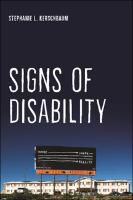Signs of Disability
| dc.contributor.author | Kerschbaum, Stephanie L. | |
| dc.date.accessioned | 2024-04-03T10:12:43Z | |
| dc.date.available | 2024-04-03T10:12:43Z | |
| dc.date.issued | 2022 | |
| dc.identifier | ONIX_20240403_9781479811175_208 | |
| dc.identifier | OCN: 1351195720 | |
| dc.identifier.uri | https://library.oapen.org/handle/20.500.12657/89490 | |
| dc.description.abstract | How can we learn to notice the signs of disability? We see indications of disability everywhere: yellow diamond-shaped “deaf person in area” road signs, the telltale shapes of hearing aids, or white-tipped canes sweeping across footpaths. But even though the signs are ubiquitous, Stephanie L. Kerschbaum argues that disability may still not be perceived due to a process she terms “dis-attention.” To tell better stories of disability, this multidisciplinary work turns to rhetoric, communications, sociology, and phenomenology to understand the processes by which the material world becomes sensory input that then passes through perceptual apparatuses to materialize phenomena—including disability. By adding perception to the understanding of disability’s materialization, Kerschbaum significantly expands our understanding of disability, accounting for its fluctuations and transformations in the semiotics of everyday life. Drawing on a set of thirty-three research interviews focused on disabled faculty members’ experiences with disability disclosure, as well as written narratives by disabled people, this book argues for the materiality of narrative, suggesting narratives as a means by which people enact boundaries around phenomena and determine their properties. Signs of Disability offers strategies and practices for challenging problematic and pervasive forms of “dis-attention” and proposes a new theoretical model for understanding disability in social, rhetorical, and material settings. | |
| dc.language | English | |
| dc.relation.ispartofseries | Crip | |
| dc.subject.classification | thema EDItEUR::V Health, Relationships and Personal development::VF Family and health::VFJ Coping with / advice about personal, social and health topics::VFJD Coping with / advice about physical impairments / disability | |
| dc.subject.classification | thema EDItEUR::J Society and Social Sciences::JB Society and culture: general::JBF Social and ethical issues::JBFN Health, illness and addiction: social aspects | |
| dc.subject.classification | thema EDItEUR::M Medicine and Nursing::MB Medicine: general issues | |
| dc.subject.classification | thema EDItEUR::D Biography, Literature and Literary studies::DS Literature: history and criticism | |
| dc.subject.other | Disability and architecture | |
| dc.subject.other | disability studies | |
| dc.subject.other | disability and deafness | |
| dc.subject.other | rhetoric and disability | |
| dc.subject.other | materialist approach | |
| dc.subject.other | perceiving disability | |
| dc.subject.other | Karen Barad | |
| dc.subject.other | agential realism | |
| dc.subject.other | intra-action | |
| dc.subject.other | sensory perception and disability | |
| dc.subject.other | disabled practices | |
| dc.subject.other | disability and praxis | |
| dc.subject.other | material environment and disability | |
| dc.subject.other | disability and storytelling | |
| dc.subject.other | Disability | |
| dc.subject.other | Deafness | |
| dc.subject.other | Rhetoric | |
| dc.subject.other | Materiality | |
| dc.subject.other | embodiment | |
| dc.subject.other | Asia Friedman | |
| dc.subject.other | Therí Pickens | |
| dc.subject.other | hearing aids | |
| dc.subject.other | closed captioning | |
| dc.subject.other | Accessibility | |
| dc.subject.other | books about disability and Accessibility | |
| dc.subject.other | Entextualization | |
| dc.title | Signs of Disability | |
| dc.type | book | |
| oapen.identifier.doi | 10.18574/nyu/9781479811175.001.0001 | |
| oapen.relation.isPublishedBy | 7d95336a-0494-42b2-ad9c-8456b2e29ddc | |
| oapen.relation.isbn | 9781479811175 | |
| oapen.relation.isbn | 9781479811144 | |
| oapen.imprint | NYU Press | |
| oapen.series.number | 4 | |
| oapen.place.publication | New York |

